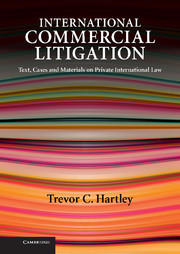Book contents
- Frontmatter
- Contents
- Table of panels
- List of figures
- Preface
- Acknowledgments
- Terminology
- Table of Latin phrases
- List of abbreviations
- Table of cases
- Table of cases (European Court of Justice, numerical order)
- Table of legislative instruments
- PART I STARTING OFF
- PART II JURISDICTION
- 2 Jurisdiction: an analysis
- 3 Jurisdiction under EC law
- 4 EC law: special jurisdiction
- 5 The traditional English rules
- 6 Developments in Canada
- 7 US law: an outline
- 8 Choice-of-court agreements
- 9 Forum non conveniens and antisuit injunctions
- 10 Overlapping jurisdiction in EC law
- 11 Special topics – I
- 12 Special topics – II
- PART III FOREIGN JUDGMENTS
- PART IV PROCEDURE
- PART V CHOICE OF LAW
- PART VI EXTRATERRITORIALITY
- Bibliography
- Index
10 - Overlapping jurisdiction in EC law
from PART II - JURISDICTION
- Frontmatter
- Contents
- Table of panels
- List of figures
- Preface
- Acknowledgments
- Terminology
- Table of Latin phrases
- List of abbreviations
- Table of cases
- Table of cases (European Court of Justice, numerical order)
- Table of legislative instruments
- PART I STARTING OFF
- PART II JURISDICTION
- 2 Jurisdiction: an analysis
- 3 Jurisdiction under EC law
- 4 EC law: special jurisdiction
- 5 The traditional English rules
- 6 Developments in Canada
- 7 US law: an outline
- 8 Choice-of-court agreements
- 9 Forum non conveniens and antisuit injunctions
- 10 Overlapping jurisdiction in EC law
- 11 Special topics – I
- 12 Special topics – II
- PART III FOREIGN JUDGMENTS
- PART IV PROCEDURE
- PART V CHOICE OF LAW
- PART VI EXTRATERRITORIALITY
- Bibliography
- Index
Summary
Since EC law is – in practice, if not in theory – based on the civil law, it is hardly surprising that the doctrine of forum non conveniens finds no place in the scheme established by the Brussels I Regulation. Instead, the doctrine of lis pendens is laid down in Article 27.
Lis pendens
Article 27 of the Regulation (set out in Panel 10.1) provides that, where proceedings involving the same cause of action and between the same parties are brought in the courts of different Member States, any court other than the court first seised must of its own motion stay its proceedings until such time as the jurisdiction of the court first seised is established. Once this occurs, it must decline jurisdiction in favour of that court.
Panel 10.1 Lis pendens: related actions Brussels I Regulation (Regulation 44/2001), Articles 27–30
Article 27
1. Where proceedings involving the same cause of action and between the same parties are brought in the courts of different Member States, any court other than the court first seised shall of its own motion stay its proceedings until such time as the jurisdiction of the court first seised is established.
2. Where the jurisdiction of the court first seised is established, any court other than the court first seised shall decline jurisdiction in favour of that court.
Article 28
1. Where related actions are pending in the courts of different Member States, any court other than the court first seised may stay its proceedings.
- Type
- Chapter
- Information
- International Commercial LitigationText, Cases and Materials on Private International Law, pp. 237 - 264Publisher: Cambridge University PressPrint publication year: 2009



